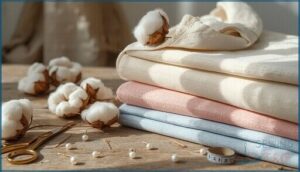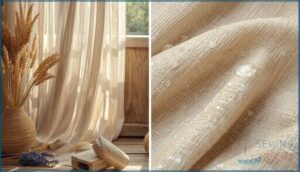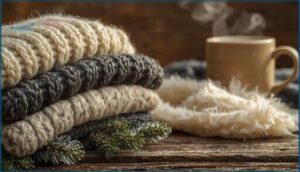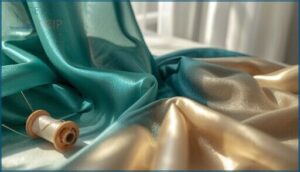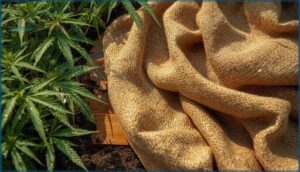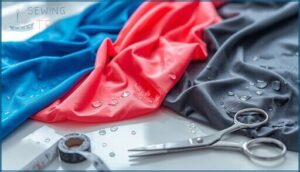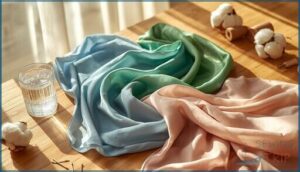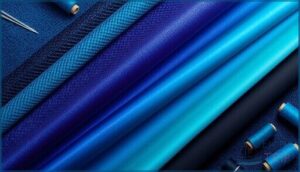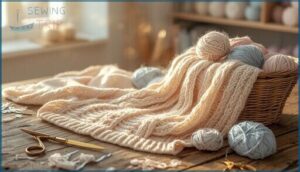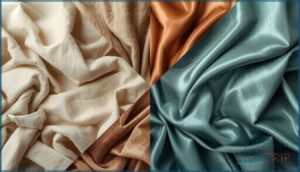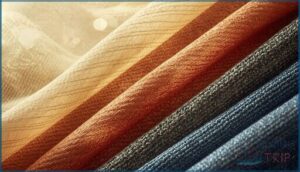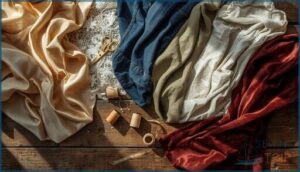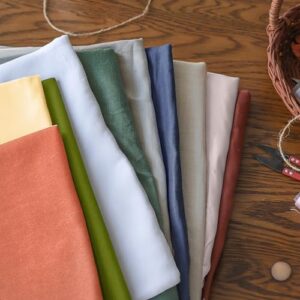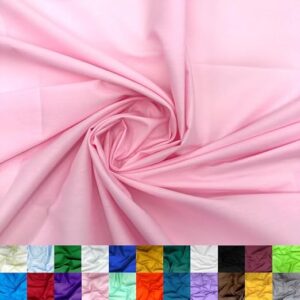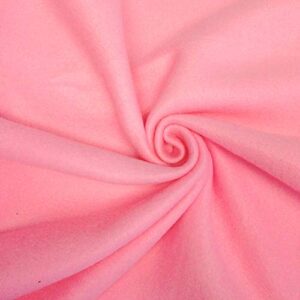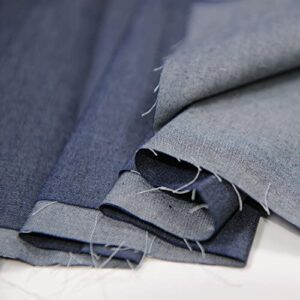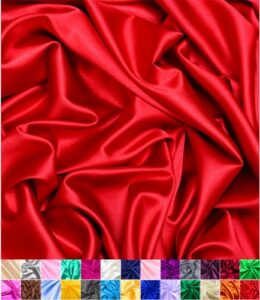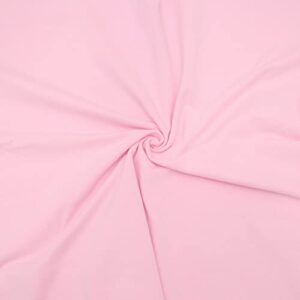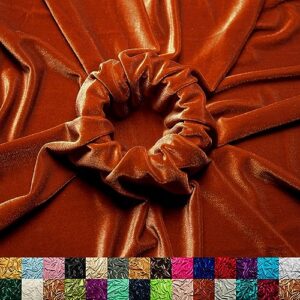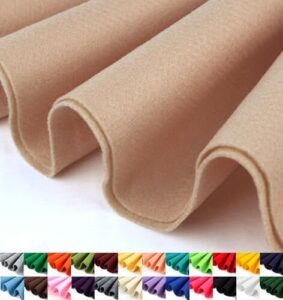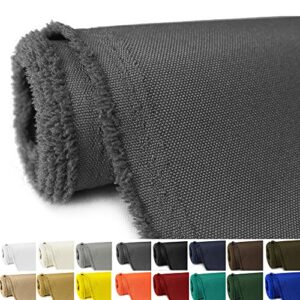This site is supported by our readers. We may earn a commission, at no cost to you, if you purchase through links.
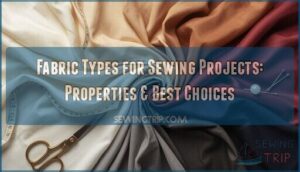
Last year, polyester alone accounted for 57% of all textile fiber production worldwide—yet it’s often the worst choice for your next sewing project. The fabric you choose shapes everything from how a garment drapes against your body to whether it’ll survive a hot summer day or five years of regular wear.
Cotton brings that soft, breathable comfort we all love, while nylon laughs at abrasion with tensile strength reaching 12,000 psi. Linen wicks moisture like a champ, and silk adds that luxurious hand you can’t fake with synthetics.
Understanding the real differences between fabric types for sewing projects means you’ll stop wasting money on materials that don’t match your vision—and start creating pieces that look professional and feel exactly right.
Table Of Contents
- Key Takeaways
- Key Fabric Types for Sewing Projects
- Cotton: Softness and Versatility
- Linen: Breathable and Textured
- Wool: Warmth and Insulation
- Silk: Luxurious and Delicate
- Hemp: Durable and Eco-Friendly
- Polyester: Durable and Easy-Care
- Nylon: Strong and Water-Resistant
- Rayon: Lightweight and Drapey
- Spandex: Stretch and Flexibility
- Acrylic: Soft and Lightweight
- Natural Vs. Synthetic Fabrics
- Fabric Construction and Properties
- Choosing The Right Fabric for Your Project
- Top 9 Fabrics for Sewing Projects
- 1. Pure Linen Fabric By The Yard
- 2. Ice Fabrics Pink Broadcloth Fabric
- 3. Barcelonetta Pink Polar Fleece Fabric
- 4. Denim Indigo Washed Cotton Fabric Yard
- 5. Satin Fabric Shiny Red Material
- 6. ITY Jersey Spandex Knit Fabric
- 7. Ice Fabrics Stretch Velvet Fabric
- 8. Tan Acrylic Felt Fabric By Yard
- 9. GeeComfy Gray Waterproof Canvas Fabric
- Frequently Asked Questions (FAQs)
- Conclusion
Key Takeaways
- Cotton and linen deliver breathability and moisture absorption that synthetics can’t match, but polyester dominates 57% of global textile production because it resists wrinkles and stands up to abrasion better than natural fibers for everyday wear.
- Fabric weight measured in GSM (grams per square meter) directly controls how a garment drapes—lightweight fabrics under 150 GSM flow beautifully for blouses, while heavyweight materials above 350 GSM provide the structure you need for jackets and upholstery.
- Woven fabrics offer 30% more stability for structured garments like trousers, while knitted fabrics bring 25-40% greater stretch for comfort-driven projects like activewear and casual tops.
- Matching fabric properties to your project’s actual use—considering factors like skin sensitivity, durability needs, climate suitability, and care requirements—saves you from wasting money on materials that won’t perform the way you expect.
Key Fabric Types for Sewing Projects
Before you start cutting or stitching, you need to understand what you’re working with. Each fabric brings its own personality to a project—some drape like water, others hold their shape, and a few offer stretch when you need it most.
Here’s a look at the key fabric types you’ll encounter, from soft naturals to hardworking synthetics.
Cotton: Softness and Versatility
Cotton comfort stands at the heart of countless sewing projects, thanks to fiber strength and moisture absorption that make this natural material a workhorse in your fabric stash. When you’re choosing among fabric types for apparel applications and home textiles, cotton delivers reliable fabric properties you can count on.
- Standard cotton fibers offer tenacity of 3.0–5.0 g/denier, balancing durability with softness
- Moisture regain around 8–9% keeps you cool and comfortable in warm conditions
- Staple lengths from 10 mm to 80 mm enable adaptable yarn construction for diverse projects
- Cotton strength increases roughly 20% when wet, perfect for towels and bathrobes
- Global cotton textile market, valued at USD 1,837 billion in 2023, reflects widespread material selection across sewing applications. The market is projected to see significant market growth reaching USD 3611.95 Billion by 2032.
Linen: Breathable and Textured
If cotton is your everyday go-to, linen will surprise you with a different kind of strength and performance. Linen’s durability comes from flax fibers that clock tensile values up to 1.5 GPa—nearly double cotton’s strength—while moisture-wicking capacity around 20% of fabric weight keeps you cooler in summer garments.
You’ll notice natural fabrics like linen offer breathability through open weaves, though the wrinkle factor and textured hand are signatures of sustainable linen’s crystalline structure and inherent stiffness. Linen is also considered a more sustainable option compared to cotton due to its minimal water and chemical needs.
| Property | Performance Detail |
|---|---|
| Tensile Strength | Up to 1.5 GPa (vs. cotton’s ~800 MPa) |
| Moisture Absorption | 12–20% by weight before feeling damp |
| Air Permeability | 30–50% greater airflow than cotton |
| Thermal Conductivity | 0.12 W/m·K (faster heat dissipation) |
| Market Share | ~0.3% of global fiber production (2023) |
Wool: Warmth and Insulation
Where linen excels in summer, wool delivers peerless warmth through crimped fibers that trap air pockets—creating thermal performance around 0.35 clo in a standard sweater.
You’ll appreciate wool’s moisture management: it absorbs up to one-third its weight while retaining 60–80% insulation when damp, making it ideal for winter garments, building insulation, and layered comfort contexts where natural fabrics outperform synthetics.
Silk: Luxurious and Delicate
Silk brings something special to sewing projects—tensile strengths reaching 300–600 MPa combined with 15–25% elongation before breakage. You’ll find it hypoallergenic and moisture-regulating, ideal for sensitive skin applications. But it demands respect:
- Hand wash in cool water to prevent shrinkage
- Iron only on low settings with a pressing cloth
- Air dry away from direct sunlight to avoid photodegradation
- Store in darkness to preserve tensile strength
Global production remains under 1% of textile output, explaining silk’s premium positioning.
Hemp: Durable and Eco-Friendly
You might think durability and environmental sustainability don’t go hand-in-hand, but hemp proves otherwise. Hemp’s strength exceeds cotton by 50–70%, while its water usage drops by up to 95%, requiring just 300–500 liters per kilogram. Additionally, hemp’s carbon sequestration reaches 8–15 tonnes of CO₂ per hectare annually. With textile performance that includes four times the moisture absorbency of cotton and market growth projecting the sector to reach $81.57 billion by 2030, hemp is a sustainable choice worth considering for fabric selection in sewing projects.
| Property | Hemp vs. Cotton |
|---|---|
| Tensile Strength | 50–70% higher |
| Water Required | 95% less (300–500L vs. 20,000L/kg) |
| Carbon Captured | 8–15 tonnes CO₂/hectare/cycle |
Polyester: Durable and Easy-Care
When you’re choosing synthetic fabrics for everyday projects, polyester delivers a rare combination of durability benefits and low-maintenance care. In 2023, polyester accounted for 57% of global textile fiber production, dominating activewear markets valued at $406.83 billion. Here’s why polyester remains a go-to fabric:
- High tensile strength ensures long-lasting garments and upholstery
- Wrinkle resistance reduces ironing time compared to cotton or linen
- Moisture-wicking properties make it ideal for athletic wear
- Stain resistance simplifies fabric care in home textiles
- Quick-drying performance reduces maintenance effort greatly
While polyester fabric offers practical advantages, recycling challenges persist—only 12.5% of polyester came from rPET adoption in 2023. Additionally, microfiber shedding during washing releases up to 1.7 grams per garment, raising environmental concerns you should weigh when selecting synthetic fabrics for your sewing projects.
Nylon: Strong and Water-Resistant
Nylon’s reputation as a workhorse fabric stems from its impressive technical specifications, which are highly valued in gear and activewear. With a tensile strength of 8,800 psi and abrasion resistance surpassing 8,000 Taber cycles, this synthetic fabric delivers exceptional performance.
The global nylon market, valued at $28 billion in 2023, reflects the growing demand for its water resistance and elastic properties across outdoor and athletic applications.
| Property | Performance Metric |
|---|---|
| Tensile Strength | 6,000-12,000 psi |
| Abrasion Cycles | 4,500-8,000 Taber |
| Elongation at Break | 15%-300% |
| Water Absorption | 4.2% |
Rayon: Lightweight and Drapey
If you’re looking for a fabric that flows like silk but costs a fraction of the price, rayon delivers that signature drape beautifully. Made from regenerated cellulose, this lightweight fabric absorbs nearly twice as much moisture as cotton—around 12–14% at standard conditions—making it breathable and comfortable in warm weather.
The global rayon market hit $20.88 billion in 2024, with apparel applications accounting for about a third of that demand. When washing rayon, stick to cold water and air drying to avoid shrinkage, since its wet strength drops sharply.
While rayon properties include excellent dye uptake and a soft hand, it’s also more biodegradable than petroleum-based synthetics, which appeals to sustainability-minded sewers. The market growth reflects rising interest in these semi-synthetic alternatives that balance performance with environmental impact considerations.
Spandex: Stretch and Flexibility
Spandex fibers stretch 500-800% at break and snap back with over 95% recovery, making them essential for any sewing project that needs serious flexibility. You’ll find this synthetic powerhouse—also called Lycra or elastane—in everything from compression garments to swimwear because of its outstanding elasticity.
The global spandex market reached $7.9 billion in 2025, driven largely by athleisure demand growing at 9% annually. When sewing with spandex blends, use a stretch stitch or ballpoint needle to prevent skipped stitches. China produced 939,000 tons in 2023, reflecting how central this material has become to modern textile production and your wardrobe’s performance needs.
- Spandex blends usually contain 5-10% for everyday wear, 15-20% for activewear applications
- Four-way stretch fabrics hold 67.2% market share in 2025
- Production methods favor solution dry spinning at 91.6% industry adoption
- Stretch recovery maintains shape even after repeated use
- Compression fabrics require 20% spandex for maximum support
Acrylic: Soft and Lightweight
Acrylic fibers mimic wool’s warmth without the weight, making them a go-to choice when you’re sewing cozy sweaters or blankets on a budget. This synthetic fabric gained traction because it holds dye brilliantly and resists moths, though it sheds microplastics during washing—something to keep in mind for your environmental conscience.
Global production hit 1.57 million tons in 2024, with China leading manufacturing. You’ll see acrylic in athletic wear, upholstery, and boot linings because it delivers excellent resiliency from bending while staying lightweight. The fabric’s tenacity ranges from 18 to 36 g/tex when dry, offering surprising durability for projects needing softness without bulk.
| Property | Performance |
|---|---|
| Density | 1.16-1.18 g/cm³ |
| Moisture Regain | 1.5-2% |
| Heat Retention | High |
| Market Value 2024 | USD 2.65 billion |
| U.S. Carpet Usage | 25% |
Natural Vs. Synthetic Fabrics
When you’re standing in the fabric store, one of the first choices you’ll face is whether to grab a natural fiber or a synthetic one. Each type brings its own strengths to your sewing table, from the soft breathability of cotton to the wrinkle-resistant convenience of polyester.
Let’s break down what makes each category work, so you can pick the right fabric for whatever you’re creating.
Benefits of Natural Fabrics
Natural fibers bring considerable benefits to your sewing projects. Cotton, linen, and hemp handle moisture beautifully—they hold between 2.5% and 11.7% water content compared to synthetic fabrics at under 0.1%. This moisture management means better skin comfort during wear. You’ll also appreciate their eco-friendliness: these materials are biodegradable and hemp offers outstanding durability—roughly 3.3 times stronger than cotton—extending your garment’s lifespan considerably.
| Property | Natural Fiber Advantage |
|---|---|
| Moisture Management | Absorbs 2.5–11.7% moisture vs. Every fabric choice carries hidden environmental costs—from cotton’s massive water use to polyester’s microplastic pollution in our oceans |
| Environmental Factor | Natural Fiber Impact | Man-Made Fiber Impact |
|---|---|---|
| Carbon Emissions | Cultivation-intensive; processing varies | 57% of production; fossil fuel–based |
| Water Consumption | High field use (cotton: ~2,120 m³/1,000 kg) | Lower manufacturing demand |
| Microfiber Pollution | Biodegradable; minimal microplastics | 730,000 fibers per wash; persistent |
| Textile Waste | Biodegradable; 85% landfilled annually | Non-biodegradable; accumulates |
| Sustainable Alternatives | Organic cotton, hemp, linen | Recycled polyester (rPET); growing market |
How to Choose Between Natural and Synthetic
Understanding your project requirements makes the choice clearer. Your skin’s sensitivity, budget, and the garment’s purpose each pull you in different directions. Comfort versus durability isn’t always a trade-off—wool insulates naturally, while polyester resists abrasion better than cotton thread of equal weight. Cost-effectiveness often favors synthetics ($0.90/meter polyester versus $8–12/yard organic cotton), yet environmental concerns and skin sensitivity might justify the premium.
| Decision Factor | When Natural Fiber Wins | When Man-Made Fiber Wins |
|---|---|---|
| Skin Sensitivity | Cotton, silk, bamboo reduce irritation; 60% of sensitive skin reacts to synthetics in humid conditions | Performance wear needing moisture transfer away from skin |
| Durability & Care | Wool’s thermal resistance outperforms thicker polyester in cool settings | Polyester’s 2.6–8.0 cN/dtex strength; wrinkle resistance; abrasion tolerance second only to nylon |
| Budget & Availability | Basic cotton at ~$0.50/meter offers lowest entry point | Spandex stretch at $1/meter; mass production keeps synthetics affordable |
Choosing the right fabric means weighing these fabric properties and uses against what you’re actually making—activewear demands different answers than a child’s pajamas or a tote bag that’ll see years of friction.
Fabric Construction and Properties
Understanding how fabric is made changes everything about how you work with it. The way fibers are turned into cloth affects stretch, durability, drape, and how easy your project will be to sew.
Let’s look at the different construction methods and properties that’ll help you pick the right fabric every time.
Woven Vs. Knitted Fabrics
When you’re choosing between woven and knitted fabrics, you’re really deciding between structure and stretch. Woven fabrics, created by interlacing perpendicular yarns, offer about 30% higher fabric stability and weave durability, making them ideal for high-stress garments like trousers.
Knitted fabrics, formed from interlooped yarns, bring:
- 25–40% greater elasticity for comfort-driven projects
- Enhanced moisture-wicking capability in activewear
- Lower production costs, with some knitting machines using just one-tenth the energy of weaving equipment
Their stretch differences shape your project outcome.
Non-Woven Fabrics and Their Uses
Unlike woven or knitted fabric types, nonwoven fabrics bond fibers directly—without weaving—making them perfect for sewing projects like interfacing and home décor. Polypropylene-based nonwovens dominate about 60% of material composition globally, while market growth is pushing toward $80 billion by 2032.
You’ll find them in hygiene applications and automotive linings. With biodegradability research advancing—some cellulose-based versions hit 70% degradation—regional dynamics show Asia-Pacific leading adoption at 41% market share.
Fabric Weight and Drape
Fabric weight—measured in GSM (grams per square meter)—directly shapes drape and stiffness, guiding your project choices. Lighter fabrics around 30–150 GSM offer fluid drape for blouses, while heavyweight materials above 350 GSM provide structure for jackets. Understanding fabric properties means you’ll match weight applications to garment needs:
- Lightweight (30–150 GSM): high drape, flowy dresses
- Medium (150–350 GSM): balanced structure, trousers
- Heavyweight (350+ GSM): low drape, outerwear
- Construction impact: tighter yarns raise drape coefficient
- Fabric characteristics: weight affects bending rigidity
Texture, Sheen, and Other Characteristics
Think of texture as your fabric’s fingerprint—roughness measurements reveal that linen runs three times coarser than cotton shirting, affecting how you’ll work with each material. Light reflectance separates matte canvas from shiny satin weaves, while colorfastness tests predict if colors survive washing.
You’ll also want to think about thermal insulation for warmth, static buildup in synthetics, and how these fabric characteristics guide material selection for your sewing projects.
Choosing The Right Fabric for Your Project
Picking the right fabric can make or break your sewing project, so it helps to match the material to what you’re making. The fabric you choose should work with your project’s purpose, whether you’re sewing garments, decorating your home, or crafting something special.
Let’s look at how different fabrics fit different types of projects so you can make smart choices from the start.
Fabric Selection for Clothing
When you’re choosing the right fabric for clothing construction, fiber performance and comfort factors should lead your decision. Natural fibers like cotton and linen offer breathability for seasonal use, while synthetics bring easy care and stretch.
Consider sustainability aspects and cost analysis alongside how the fabric will behave during wear—drape, moisture management, and thermal properties all shape your apparel design success in fabric selection for sewing projects.
Fabrics for Home Décor and Upholstery
When you’re tackling home décor and upholstery, durability becomes your north star. Market trends show polyester blends dominate the upholstery sector at roughly 55-60% share, prized for their fabric performance and cost analysis benefits. Sustainable options like cotton and linen are gaining ground in premium segments.
Here’s what matters most:
- Fabric durability and performance: Look for Martindale ratings of 15,000+ for everyday seating
- Fabric weights and uses: Heavyweight canvas and velvet suit different applications
- Fabric flammability: Commercial projects demand CAL 117 or NFPA 260 compliance
- Upholstery durability: High-traffic areas need 30,000+ rub counts
- Home decor projects: Balance aesthetics with practical wear resistance
Best Fabrics for Quilting and Crafts
Quilting and crafts thrive on cotton fabric, which claims 42.7% of the global quilt market and drives a quilting cotton sector valued at USD 7.5 billion in 2023. You’ll find cotton varieties dominating your stash composition, with prints at 20% and batiks at 17%, while wool felt appeals to DIY enthusiasts in a market projected to hit USD 33.71 billion by 2032. Precut costs vary: fat quarters average USD 16.04 per yard, though 2.5-inch squares jump to USD 32.27. Market growth reflects your passion—sewing projects fuel consistent demand.
| Fabric Type | Primary Use | Cost Consideration |
|---|---|---|
| Cotton prints | Quilts, apparel | USD 11.71/yard average |
| Wool felt | Crafts, décor | Premium hobby material |
| Precut bundles | Quick projects | USD 16–32/yard range |
Matching Fabric Properties to Project Needs
After stocking up on quilting cottons and craft felts, you’ll need to match fabric properties to your specific sewing project. Weight and drape guide your material selection—lightweight voiles suit flowing blouses, while heavyweight canvas accommodates bags and upholstery. Climate suitability matters: linen breathes in summer heat, wool insulates in winter. Durability factors and care requirements shape longevity, so evaluate abrasion resistance and laundering needs before cutting your first pattern piece.
Key fabric selection considerations for your sewing project:
- Weight influences structure – 2–3 oz fabrics drape beautifully for dresses; 12+ oz materials provide stability for coats and furniture
- Climate drives comfort – cotton and linen excel in warm weather; polyester wicks moisture during active pursuits
- Durability matches use intensity – nylon and polyester resist abrasion in high-wear garments; canvas withstands heavy-duty applications
- Care requirements affect practicality – machine-washable cotton suits everyday wear; silk demands gentle handling for special occasions
- Project guidelines yield results – follow pattern recommendations for fiber type, stretch, and GSM to achieve professional fit and finish
Top 9 Fabrics for Sewing Projects
Now that you know how to match fabric properties to your project needs, let’s look at some standout options you can actually buy.
The following nine fabrics cover everything from natural linens to stretch knits, each bringing something different to your sewing table.
You’ll find choices for garments, home décor, and specialty projects that deliver on both performance and quality.
1. Pure Linen Fabric By The Yard
When you’re ready to invest in pure linen fabric by the yard, you’re choosing one of the most sustainable natural fibers available. Linen properties like 10-12% moisture regain keep you cool in warm climates, while its tensile strength around 5.5-6.5 g/den ensures durability for your sewing project.
This 100% natural fabric—78 inches wide, 160GSM weight, with serged edges—works beautifully for clothing, tablecloths, and curtains.
Just remember: linen’s low elasticity means it wrinkles easily, so factor that into your fabric types selection and follow gentle care instructions.
Best For: Home sewers and crafters who want durable, breathable fabric for summer clothing, home textiles, or DIY projects and don’t mind the natural wrinkling that comes with linen.
- Highly breathable with excellent moisture absorption (10-12% regain), keeping you cool and comfortable in warm weather
- Strong and long-lasting with superior tensile strength compared to cotton, perfect for items that need to hold up over time
- One of the most sustainable fabric choices available, requiring minimal chemicals and acting as a carbon sink during growth
- Wrinkles easily due to low elasticity (2-3% stretch), so it’s not ideal if you want a crisp, pressed look all day
- May shrink slightly after the first wash, so you’ll need to account for that when planning your project
- Colors can vary slightly from what you see online, and multiple yards don’t come as one continuous piece
2. Ice Fabrics Pink Broadcloth Fabric
If you want a flexible alternative for sewing project materials, Ice Fabrics’ pink broadcloth—a poly-cotton blend at 60 inches wide—offers a crisp, smooth plain weave that’s perfect for shirts, blouses, and craft work.
This fabric composition (roughly 65–80% polyester, 20–35% cotton) balances wrinkle resistance with breathability, and its approximately 120 g/m² weight makes cutting and stitching straightforward. Color properties stay vibrant through machine washing, though you’ll find broadcloth uses work best for lightweight garments rather than heavy upholstery.
Care instructions are simple: warm-water wash, quick-dry, minimal ironing—ideal sewing suitability for beginners exploring fabric characteristics.
Best For: Sewers looking for an easy-care, budget-friendly fabric for lightweight garments like blouses, dresses, and shirts, or anyone tackling beginner-friendly craft projects that need a crisp, smooth finish.
- Machine washable with minimal wrinkling and quick drying thanks to the polyester blend, so you spend less time ironing and more time sewing.
- Wide 60-inch width gives you plenty of fabric to work with per yard, cutting down on seams and waste for larger projects.
- Holds color well through repeated washes and resists fading, keeping your pink projects looking fresh over time.
- Some users find it too thin for structured garments, so it works better as a lining or for flowy styles rather than tailored pieces.
- The synthetic polyester content means it’s less breathable than pure cotton, which might feel less comfortable in hot weather.
- Screen colors can vary, so the pink shade you see online might not perfectly match what arrives at your door.
3. Barcelonetta Pink Polar Fleece Fabric
For cozy fleece blankets that won’t break the bank, Barcelonetta’s pink polar fleece delivers practical cost effectiveness at roughly 72 by 60 inches. This 100% polyester fabric option weighs in around 320 g/m², balancing thermal properties with breathability—think medium warmth for sewing projects like throws, ponchos, or pet beds.
Fleece applications extend from home décor to lightweight apparel, and sewing considerations are minimal since edges resist fraying. Durability maintenance is straightforward: cold-water wash, skip the heat, and the anti-pill finish holds up well.
Understanding fabric characteristics helps you match material to purpose.
Best For: DIYers and crafters looking for an affordable, easy-to-sew fleece for blankets, throws, pet beds, and lightweight layering pieces where medium warmth and softness matter more than heavy insulation.
- Budget-friendly pricing for a generous 72″ × 60″ cut that covers most blanket and throw projects without needing multiple yards.
- Anti-pill finish and machine-washable polyester hold up well over time with simple cold-water care and no special handling.
- Edges don’t fray when cut, making it beginner-friendly and perfect for no-sew or quick-finish projects like fleece blankets and simple accessories.
- Some users find the fabric too thin for heavyweight blankets or outerwear, especially if you’re expecting the heft of premium fleece.
- Color accuracy can be hit-or-miss—a few customers report receiving shades that don’t match the online photos.
- Medium weight (around 320 g/m²) may not provide enough insulation for very cold climates or high-warmth applications like winter jackets.
4. Denim Indigo Washed Cotton Fabric Yard
At five ounces per square yard and fifty-eight inches wide, this indigo washed denim lands in the lighter spectrum—ideal for sewing everyday jeans, skirts, or button-downs without wrestling a heavyweight weave. The 100% cotton composition breathes well, though you’ll want to factor in about two inches of shrinkage per yard after washing.
Indigo dyeing can bleed, so pre-wash separately. Project suitability leans toward garments that benefit from drape over rigid structure, making this fabric a solid choice for casual apparel and creative quilting experiments.
Best For: Home sewers looking for soft, breathable fabric to make lightweight jeans, casual shirts, skirts, and dresses without dealing with stiff, heavy denim.
- Lightweight 5oz weight makes it easy to sew and comfortable to wear, with good drape for garments that need movement rather than stiff structure.
- Wide 58-inch width gives you more fabric per yard, reducing waste and seam placement challenges in larger pattern pieces.
- 100% cotton breathes well and softens further with washing, ideal for everyday garments worn close to the skin.
- Shrinks about 2 inches per yard after washing, so you’ll need to buy extra yardage or pre-wash before cutting your pattern.
- Indigo dye tends to bleed and transfer, requiring separate pre-washing and careful handling during early laundry cycles.
- Too lightweight for projects needing heavy-duty denim structure like workwear or rigid jeans, disappointing some customers expecting traditional denim weight.
5. Satin Fabric Shiny Red Material
This shiny red material gets its signature gloss from a satin weave structure—floating yarns reflect light intensely, creating that eye-catching finish you see in evening gowns and formal décor.
Most versions run about 160 GSM polyester at sixty inches wide, balancing drape with enough body for structured sewing projects. Satin durability varies: polyester resists wear better than silk, though both fray easily during cutting.
Red dyeing holds well on polyester using disperse dyes. Care instructions call for low-heat ironing with a pressing cloth to avoid melting or water spots on special occasion wear.
Best For: Anyone sewing formal dresses, wedding décor, or costume pieces who wants that glossy red look without the cost or fussiness of silk.
- Bright, light-reflecting finish makes red tones pop in evening gowns and statement garments
- Polyester versions are durable, colorfast, and machine-washable on gentle cycles
- Wide 60-inch rolls let you cut full skirts and wide pieces with fewer seams
- Frays extremely easily during cutting and sewing, requiring careful handling
- Low heat tolerance means you need a pressing cloth and patience when ironing
- Mixed reports on thickness and occasional water stains straight from the roll
6. ITY Jersey Spandex Knit Fabric
ITY jersey spandex knit fabric blends roughly 95% polyester with 5% spandex, giving you a medium-weight knit that stretches about 40% vertically and 20% horizontally—perfect for dresses, tops, and leggings that need comfort without bagging.
This interlock construction sits around 240 GSM at sixty inches wide, draping smoothly while staying opaque. You’ll find it withstands wrinkles and accepts machine washing in cold water, though you should skip high heat to protect the spandex’s recovery.
Its polished surface makes printed colors pop in garment applications.
Best For: Sewers and designers looking for a stretchy, wrinkle-resistant fabric that drapes well for dresses, tops, leggings, and activewear without losing shape over time.
- Two-way stretch (40% vertical, 20% horizontal) offers comfortable fit and freedom of movement in fitted garments
- Wrinkle-resistant and machine washable, making it ideal for travel clothing and everyday wear with minimal maintenance
- Smooth, polished surface with good opacity at 240 GSM creates vibrant prints and a dressier appearance than typical cotton jerseys
- Spandex content requires low-heat care—high temperatures during washing or ironing can damage elasticity and cause premature wear
- Some variations may be thinner or more see-through than expected, potentially requiring lining or doubled layers for adequate coverage
- Color accuracy can vary from online images, and the polyester blend may pill over time with friction despite proper care
7. Ice Fabrics Stretch Velvet Fabric
Ice Fabrics stretch velvet fabric composition blends 90% polyester with 10% spandex at 60 inches wide, delivering up to 20% vertical stretch for form-fitting dresses, costumes, and upholstery.
This 330 GSM material rates at 10,000 double rubs for durability metrics, resisting abrasion in medium-traffic sewing projects. You’ll appreciate its four-way stretch option for body-skimming garments while maintaining elastic recovery.
Hand wash in cold water or choose delicate cycles, then hang dry to preserve the pile’s plush texture and prevent sagging in your finished velvet creations.
Best For: Sewers and crafters who need a durable, stretchy velvet for form-fitting garments, costumes, or upholstery projects that require both flexibility and a luxurious texture.
- Four-way stretch with up to 20% vertical give makes it perfect for body-hugging dresses and performance wear that need to move with you
- Strong durability at 10,000 double rubs means it holds up well to regular use without showing wear or developing bare spots
- Easy maintenance with hand wash or delicate cycle options, plus it’s wrinkle-resistant so you spend less time fussing with care
- The stretchy nature can be tricky for beginners to cut and sew without the fabric shifting or puckering
- Color accuracy isn’t guaranteed—what you see online might not match what arrives at your door
- At 0.65mm thickness it’s somewhere in the middle, so it won’t work if you need something really opaque or structured
8. Tan Acrylic Felt Fabric By Yard
Acrylic felt durability shines in projects that need simple construction without frayed edges—that’s why it’s your go-to for masks, ornaments, and classroom crafts. This tan felt fabric spans 72 inches wide at 1.6mm thickness, offering medium stretch for costume design and felt sewing techniques.
With acrylic felt market trends pointing toward USD 9.2 billion by 2035, craft felt applications keep expanding.
Hand wash gently and air dry flat to prevent pilling, following this felt care guide for fabric types that balance affordability with non-woven flexibility in sewing and craft projects.
Best For: Crafters and DIY enthusiasts who need affordable, wide-width felt for costumes, school projects, home decor, and accessories where durability and ease of cutting matter more than premium wool quality.
- No fraying or edge finishing required thanks to non-woven construction, making it beginner-friendly for hand or machine sewing
- Extra-wide 72-inch width minimizes seams in large projects like backdrops, garlands, and costume pieces
- Budget-conscious alternative to wool felt that still offers stain resistance and medium stretch for shaping
- Prone to pilling with frequent handling, so it’s not ideal for items that get heavy use
- Requires gentle hand washing and air drying to avoid shrinkage, which adds care time compared to washable fabrics
- Lower density than premium German or wool felts, so texture and durability won’t match high-end materials
9. GeeComfy Gray Waterproof Canvas Fabric
When outdoor sewing projects demand serious waterproof performance, this 600D gray canvas fabric withstands everything from boat covers to travel gear. You’ll work with 100% polyester construction at 220 GSM weight, backed by durability metrics that include 50,000 double rubs resistance and 5300 mmH2O hydrostatic rating—making fabric selection for sewing applications like backpacks and tarpaulins straightforward.
Material specifications show 58-inch width cuts that machine wash easily. Care instructions stay simple: spot clean or hand wash, then air dry.
These fabric properties and fabric types suit projects where weather resistance matters most.
Best For: DIY sewers and crafters who need affordable, waterproof fabric for outdoor gear like boat covers, backpacks, and patio furniture without worrying about getting caught in the rain.
- Seriously waterproof with a 5300 mmH2O rating that keeps liquids out completely, plus it dries fast if it gets wet.
- Heavy-duty construction with 50,000 double rubs resistance means your finished projects won’t wear out quickly from regular use.
- Easy care routine since you can machine wash it or just spot clean when needed, and it won’t lose its shape.
- The polyester material can feel plasticky and might have a chemical smell when you first open it.
- Not fade-proof, so bright sunlight will eventually bleach out the color over time.
- Arrives stiff with creases that might not come out, which can make sewing tricky until you work with it a bit.
Frequently Asked Questions (FAQs)
How do you choose a fabric for a sewing project?
You choose fabric for a sewing project by considering your skill level, project needs, and budget constraints.
Match fabric properties like weight and drape to your aesthetic preferences and material selection goals.
What fabrics can you sew with?
You can sew virtually anything—think of fabric as clay in your hands.
From crisp cotton and breathable linen to stretchy spandex and durable nylon, fiber blend options span countless sewing fabric types, matching diverse project fabric needs perfectly.
Which fabric should a beginner sew?
Cotton quilting fabric stands out for beginners due to its ease of sewing and cost effectiveness. Its stable weave minimizes shifting, while its medium weight aids skill-building without delicacy concerns—perfect for mastering fundamental techniques confidently.
What are the different types of fabric?
Fabric types fall into two fiber classifications: natural (cotton, linen, wool, silk, hemp) and synthetic (polyester, nylon, rayon, spandex).
Understanding fabric types helps you recognize properties, select sustainable options, and explore performance fabrics for any project.
How to choose the best fabric for beginners?
For beginner-friendly fabric selection, you’ll want stable weaves like cotton poplin or lightweight quilting cotton—they offer excellent sewing ease around 120-150 GSM weight, minimal shrinkage rates, and forgiving stretch properties that make material selection straightforward.
What are the most durable fabric options?
When your work faces serious wear, think tensile strength and abrasion resistance. Heavyweight denim withstands over 8,000 cycles, linen reaches 5,500, while ballistic nylon outperforms both—durability testing reveals material selection matters for heavy-duty fabric longevity.
How do fabric properties affect sewing ease?
Weight, stretch recovery, and weave structure shape how easily you’ll sew. Lighter fabrics pucker more readily, while high-stretch materials need careful needle handling. Understanding these mechanical properties helps match fabric characteristics to your skill level.
Which fabrics are most breathable for clothing?
Natural fibers like cotton, linen, and wool lead in breathability—cotton absorbs moisture, linen offers greater air permeability, and wool regulates vapor transfer.
Performance fabric blends with moisture-wicking synthetics improve comfort for active wear.
What fabrics require special sewing techniques?
Sheer fabric like chiffon needs fine needles and tissue support, while stretch knits require ballpoint tips.
Heavyweight fabrics use larger needles, waterproof textiles demand seam sealing, and pile fabrics benefit from walking feet.
How do I preshrink fabric before sewing?
Before sewing, preshrink your fabric to prevent post-project disasters. Wash cotton and linen at your planned temperature, then tumble dry. Steam wool carefully.
Test colorfastness first—a simple swatch saves heartache later.
Conclusion
Sure, you could keep gambling on mystery fabrics and hoping your lined jacket doesn’t turn into a sweat lodge—or you could actually use what you now know.
You’ve got the breakdown on fabric types for sewing projects, from cotton’s breathability to nylon’s bulletproof strength. Match fiber to function, construction to drape, and suddenly your creations stop looking homemade and start looking intentional.
Your next project deserves better than guesswork.
- https://www.marketgrowthreports.com/market-reports/cotton-market-112911
- https://www.fortunebusinessinsights.com/organic-cotton-market-106612
- https://www.statista.com/statistics/1250812/global-fiber-production-share-type/
- https://blog.qima.com/sustainability/recycled-polyester-fabric-transforming-textile-industry
- https://valaalta.co/blogs/writings/linen-fabric-for-the-21st-century

